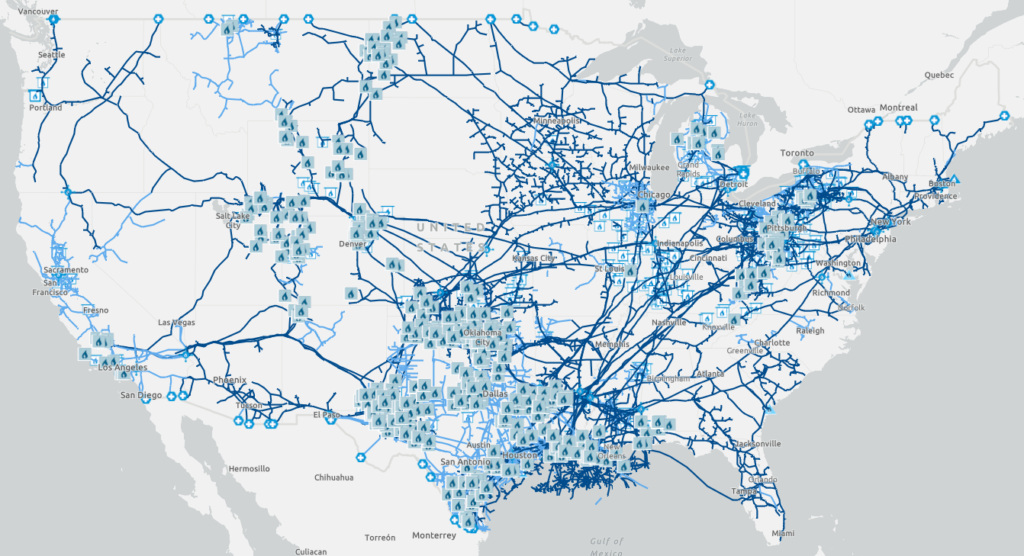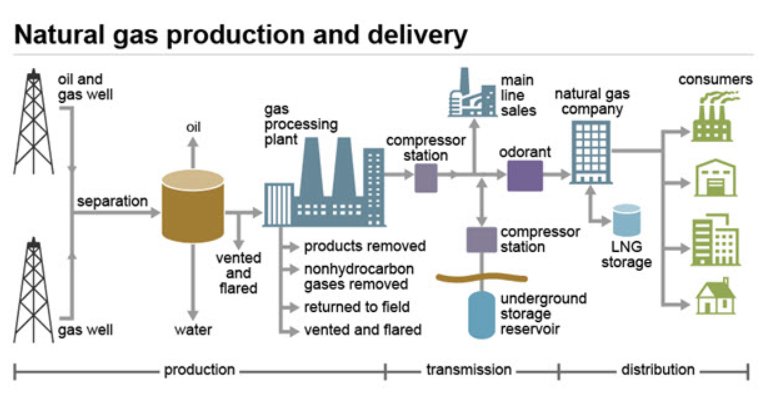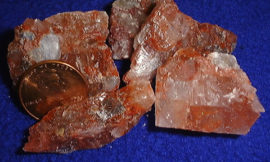In this episode we talk about what the midstream sector in the oil & gas industry does and how it affects royalty owners. From marketing and managing royalty payments for some operators to separating out the high value NGL’s from your gas stream, the midstream oil & gas sector has a big impact on most royalty owners.
Be sure to also subscribe on Apple Podcasts via the link above and please leave us an honest rating and review. We read every one of them and sincerely appreciate any feedback you have. To ask us a question to be featured on an upcoming episode, please leave a comment below or send an email to feedback@mineralrightspodcast.com.
What Does the Midstream Segment Do?
Upstream
First it is helpful to understand all of the different segments within the oil & gas industry. First is Upstream – this consists of the exploration and production of the oil & natural gas and associated products. From drilling & completing wells to production and the initial processing onsite at the well pad this is all part of what is called the upstream sector in oil & gas.
Downstream
At the other end of the value chain is the Downstream sector. This consists of the refineries, chemical plants, terminals, and transportation to get the end products to consumers. For example, the refineries, refined products pipelines, storage facilities and terminals where tanker trucks fill up with gasoline and deliver it to a gas station where consumers ultimately purchase and use the gasoline and diesel. These are all part of the downstream sector.
Midstream
The midstream oil & gas segment is the intermediary between the upstream and downstream industries. A great example of where midstream fits in is it transports raw natural gas from the wellsite to a gas plant where it can be processed into different components such as natural gas, propane, butane, and other natural gas liquids. Within an oil and gas field there are what are called gathering pipelines that connect each wellpad to a central facility where the raw oil, gas, and water can be separated and either sold or sent for further processing. Or there may be separate oil, water, and gas gathering lines that may take water to a saltwater disposal facility, the oil is shipped to market, and the raw gas can then be sent via pipeline to a gas plant.
What Types of Facilities Make up the Midstream Sector?
In general, there are several key types of facilities that make up the midstream oil & gas sector. Each of these are a key part of getting oil and gas and associated products from where they are produced to where they are used.
- Pipelines (gathering and transmission lines)
- Compressor stations (gas)
- Processing facilities (Gas plants, water treatment)
- Storage facilities
Key Steps in the Midstream Value Chain
The midstream sector has several key elements that make up the midstream value chain. These steps play an important role in the movement and processing of the raw oil and gas from the wellhead to where it can be marketed and sold.
- Gathering – Natural gas gathering is an important step in the oil & gas industry value chain. Before sending the gas to the gathering pipeline, oil and gas operators will separate out the water and oil from the gas so that these other product streams can be handled separately. The operator may also do some initial processing at the wellsite using heater-treaters and some initial dehydration with the goal of removing as much water as possible before it is metered and sent to the gathering system. The reason for this is because water decreases the heating value of the gas and because it causes problems when the midstream company tries to compress the gas since water is not compressible. In order to boost the pressure at the wellhead it typically needs to go through a compressor so that it will flow to the gas plant for processing.
- Processing – After the gas has been gathered it is typically sent to a gas plant within that basin or field so that it can be purified to natural gas standards so it can be used. Even more important from a royalty owner point of view, the gas plant is where the heavier hydrocarbon liquids are separated out from the natural gas or methane. To do this, they cool the gas down to -200 degrees F. These hydrocarbon liquids are called Natural Gas Liquids or you may also see the term Plant Products on your royalty checks. These are the butanes, iso-butane, propane, and ethane that can then be used to make things like plastics or in the case of propane, for use in your gas grill.
- Transportation/Storage – Once the natural gas is processed, it is sent to a transmission pipeline to transport it from the natural gas producing area to the area where it will be used. In major cities and towns there are distribution pipelines and hubs that connect to each customer. Since the demand for natural gas fluctuates based on many factors, it might need to be stored before it is used. Large underground caverns are used for natural gas storage and this provides an additional buffer for when demand increases suddenly due to cold weather or hot weather when more natural gas is needed to generated the electricity necessary to cool our homes and businesses.
- Marketing – Many oil & gas operators will outsource the marketing of the oil & gas to a midstream company. This involves finding buyers for natural gas and NGL’s such as distribution companies and end uses or other marketers or resellers. The marketing component can have a big impact on the royalties that we are paid. This is the operator will have a marketing contract with an oil and gas marketer or processor. In some cases the oil or gas may issue the checks to the royalty owners.
How Midstream Affects Royalty Owners
It’s important for royalty owners to understand that each operator will have different marketing and midstream contracts and those contract terms can have a huge impact on the actual price that we’re paid when oil or gas is sold.
This can be especially true with natural gas where the operator may have to agree to certain minimum volume commitments in order to get a midstream company to build the gathering, transportation, and processing infrastructure. If the operator does not deliver these minimum volumes over time, they may be on the hook for paying for the difference between what is actually produced and sold and what they said they would do. This may affect the ultimate price that is received by the operator and by extension, the royalty owner.
Midstream contracts can have a big impact on the price that royalty owners receive for the sale of oil and gas. Royalty owners are usually at the mercy of the operator when it comes to pricing but if you are large enough and your oil and gas lease allows it, you may be able to enter into separate marketing contracts for your share of the oil or gas that is produced.
Location of Midstream Facilities
The Energy Information Administration has an interactive map where you can view natural gas infrastructure and resources in the U.S. Here is a high-level view of where some of the natural gas processing plants and pipelines are located:

Source: U.S. Energy Information Administration (February 2023)
Summary
In conclusion, the midstream oil & gas industry is a critical aspect of the oil and gas supply chain. It plays an essential role in the transportation, storage, processing, and marketing of oil and gas products. The industry’s importance to the economy, job creation, and the development of oil & gas in an area cannot be overemphasized. The midstream sector can have a major impact on the royalty owner, from the timing of when wells are drilled, where they are drilled, and how much we are paid for the sale of any oil, gas, or NGL’s that are produced.
Resources Mentioned in This Episode
- What is Midstream Oil and Gas? – EKT Interactive
- What is Midstream? (GPA Midstream Association)
- The 10 Biggest Pipeline Companies | Investing.com
- MRP 97: How to Audit Your Oil and Gas Royalty Statements
- MRP 166: How to Read and Manage Your Royalty Statements
- MRP 13: Royalty Audits and Litigation with Attorney Spencer Cox
Thanks for Listening!
To share your thoughts:
- Leave a comment or question below (we read each one and your question may be featured in a future episode)!
- Ask a question or leave us feedback via email.
To help out the show:
Click the Apple Podcasts Logo Above to leave us a rating & review. It really helps us reach those that need to hear this information and only takes a minute. We greatly appreciate it! Plus, you can get a shout out on a future episode!
Thanks again – until next time!




